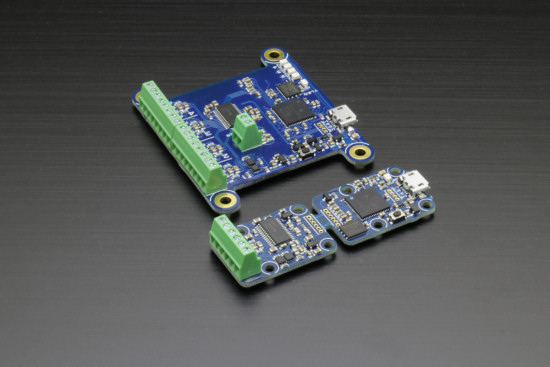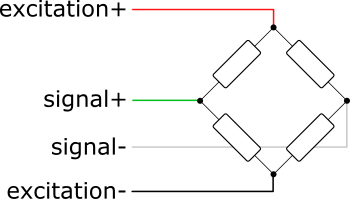![]() This week, we are proud to present two new Yoctopuce modules on which we have been working for a long time: the Yocto-Bridge and the Yocto-MaxiBridge. They enable you to easily interface Wheatstone bridges... that is, you can build you own USB scale or weighing machine. Let's see what it's all about.
This week, we are proud to present two new Yoctopuce modules on which we have been working for a long time: the Yocto-Bridge and the Yocto-MaxiBridge. They enable you to easily interface Wheatstone bridges... that is, you can build you own USB scale or weighing machine. Let's see what it's all about.

The Yocto-Bridge and the Yocto-MaxiBridge
Ratiometric sensors and Wheatstone bridges
These two modules can interpret the output of a Wheatstone bridge ratiometric output sensor. The output of this kind of sensor is proportional to both the physical value measured by the sensor and the excitation voltage that is applied to it. Therefore their sensitivity is usually expressed in mV/V.

A Wheatstone bridge
This type of architecture is typical of load cells used in most electronic weighing machines. These cells are made of a metallic block to which Wheatstone bridge resistances are pinned. When a block deforms, under the influence of a weight for example, the resistances value changes , which affects the bridge output voltage. By accurately measuring this voltage variation, we can compute the force/weight which deformed the block. This is exactly what the Yocto-Bridge and the Yocto-MaxiBridge do.

A few load cells
.
The Yocto-Bridge

The Yocto-Bridge
The Yocto-Bridge can thus excite and measure the output of a load cell. When you have calibrated it for the load cell you are using, the module can even automatically convert the electric value that it read into a weight unit. But it won't do a simple linear conversion, it contains advanced features that you won't necessarily find in all available load cell interfaces.
Zero-tracking
Load cells have an intrinsic defect: they all drift more or less, in particular when there are temperature changes. As this drift is rather slow, one of the techniques to compensate this type of issue consists in systematically cancelling measures below a predefined threshold by automatically re-taring. It's what all commercially available electronic weigh scales do. The Yocto-Bridge does it too.
Compensation in temperature
The zero-tracking trick works only if the scale is idle and empty most of the time. For weighing machines that remain loaded all the time, you really need to compensate for temperature changes. The Yocto-Bridge can do it automatically for you: not only does it have an internal temperature sensor, but it also has an input for a thermistor, which enables you to put a temperature sensor as close as possible to the load cell. Note that if most load cells proudly announce that they are already compensated in temperature, this compensation is often insufficient.
Compensation in amplitude
Changes in temperature do more than move the zero of the scale, they also affect the amplitude of load cells output. The phenomenon is usually minimal, but it is there. If this becomes an issue, the Yocto-Bridge can correct these deviations with correction tables previously injected in the system.
AC excitation
Accurately measuring the output of a load cell implies being able to measure voltage differences in the order of 10nV. At this resolution, thermocouple effects between solders and conductors in measurement electronics can start to occur, but one can cancel their effect by applying excitation in one direction and then another. This is why the Yocto-Bridge can provide a DC excitation as well as an AC excitation.
Linearity correction
Load cells are never perfectly linear. As all Yoctopuce sensors, the Yocto-Bridge can correct linearity defects with correction tables previously injected in the system.
Accuracy
The Yocto-Bridge is based on a 32bit analog/digital converter manufactured by Texas Instruments. This high end converter is equipped with advanced filters which allow you to hope for an accuracy in the order of 0.01%, as long as the Yocto-Bridge is used with good quality load cells. Indeed, you probably won't be able to convert your €15 kitchen scale into a jeweler's scale, but if you invest in a good cell, you can obtain remarkable results.
The Yocto-MaxiBridge

The Yocto-MaxiBridge
Small scales are often based on a weighing pan resting on a single load cell. But as soon as you deal with bulky loads, it becomes hard to stabilize them on a single point. Therefore, large scales usually use 4 cells. Hence the Yocto-MaxiBridge which is the equivalent of the Yocto-Bridge with four inputs. Each input is measured one after the other as an independent scale and the Yocto-MaxiBridge automatically performs the addition. You can naturally configure the number of used inputs, so you can build scales with 4, 3, 2, or only one cell. Note that nothing prevents you from using the Yocto-MaxiBridge to manage four completely independent weighing machines.

One of the weighing machines that we built to test the Yocto-MaxiBridge
.
Demo
To conclude, here is a short demo of a Yocto-Bridge connected to a home-made scale, itself based on a Variohm AL6B-L-0.3kg-0.4B load cell. It took us less than an afternoon to make this small DIY project. The scale can weight up to about 250g and has an accuracy in the order of the hundredth of gram.


